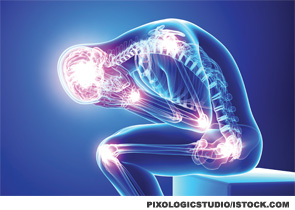
Editor’s note: Also see “False Assumptions”.
Case Study 1
A 34-year-old male presented to a rheumatologist for treatment and chronic pain. The patient had severe ankylosing spondylitis (AS) and end-stage hip osteoarthritis. Orthopedics was trying to avoid performing a hip replacement on him at such a young age. The rheumatologist was comfortable prescribing opioids and has treated many patients with scheduled drugs. The patient has had chronic pain for many years and has undergone multiple treatments, including physical therapy, steroid injections and many medications. On presentation, the patient was also on methocarbamol and oxycodone/acetaminophen (four times a day). His past history was positive for hypertension and alcohol abuse, although he stated he had not consumed alcohol in the past year. He worked as a laborer.
On exam, the patient was in moderate distress with his back pain. His blood pressure was elevated at 160/100. Low back and neurologic exam were normal. He had a decreased Schobers of 8 cm. X-rays showed severe AS and osteoarthritis of the right knee. The physician instituted infliximab at 400 mg/month, oxycodone at 10 mg (BID) for pain control and clonazepam for muscle spasm. On a follow-up visit two weeks later, the oxycodone was increased to 30 (BID).
Two days after the follow-up visit, the patient picked up the medicine at a local pharmacy. The next morning, the patient was found unarousable by his roommate and declared dead on scene by paramedics. The cause of death was polysubstance drug overdose with evidence of opioids, benzodiazepines and alcohol on the toxicology screen. A lawsuit was filed against the physician.
Case Study 2
A rheumatologist had been seeing a 65-year-old female patient for years. The patient had severe rheumatoid arthritis and had taken many prednisone courses over the years. She developed an osteoporotic thoracic spine fracture and was eventually prescribed hydrocodone/APAP 5/325, 240 pills a month.
Because of the increased publicity surrounding the opioid epidemic, the physician worried that the patient was getting too much medication. This was only one of a handful of patients in his practice on opioids. As time went on, the patient became increasingly belligerent with the physician’s staff, and he decided to terminate her from his practice. The physician wrote a dismissal letter to the patient. There were several loud and angry phone calls during the next month. Three months later, the physician received a complaint letter from the state medical board. The physician called the risk manager of his medical group and asked, “Did I do anything wrong here?”
Case Analysis
The first case revolves around the issue of responsible prescribing. Was there an adequate assessment of the risk factors for accidental overdose in this patient, and was the therapy appropriate for the patient’s diagnosis? Was there thorough documentation around the risks and benefits of opioids, and were there attempts to wean or use alternative treatments? Were there discussions with the patient about the issues of polypharmacy and concurrent use of alcohol? Was there an opioid agreement and consent in place? If the answers to these questions were documented in a manner that shows reasonable care, then this will be a very defensible case.
The second case revolves around the physician’s legitimate concern about opioid overuse. Did he present a tapering schedule to the patient? Was there an adequate bridge of medicine while the patient transitioned to another provider? Was this physician the first and only prescriber of the opioids? Did the physician discuss the risks, benefits and alternatives of beginning and escalating opioid therapy for a chronic non-cancer indication? These are the questions that will be raised if the physician finds himself defending his actions against an abandonment allegation.

Discussion
Prior to the 1990s, physicians were prohibited from effectively treating chronic non-cancer pain with high-dose opioids. Pain physicians, advocacy groups and, perhaps, the pharmaceutical industry honed in on our undertreatment of pain, resulting in increased attention to pain—and increased opioid sales.
The common belief was that there was no limit on maximum dosage. Pain was considered the fifth vital sign.1 “Smiley faces” and 10-point pain scales became widespread. Most of us prescribed out of an honest intent to treat pain compassionately and prevent suffering. Perhaps the increased concern for nonsteroidal antiinflammatory drug (NSAID) toxicity, which all rheumatologists were aware of, contributed to the rise of opioid use. In 2011, the Institute of Medicine released the report, “Relieving Pain in America,” in which it was estimated that 100,000 adults are affected by chronic pain.2 Retrospectively, it is clear that there was an absence of evidence-based literature addressing safe and effective opioid use.
Then the tide changed. In 2013, the Centers for Disease Control and Prevention (CDC) published a study indicating a strong association between increased opioid sales and overdose deaths. They estimated that more than 60% of overdose deaths are related to pharmaceuticals. Forty percent of deaths relate to doctor shopping and diversion of these drugs.3 In 2009, more people died accidentally of prescription drug overdoses than from motor vehicle accidents. The 100,000 who are estimated to have died from opioid overdoses from 1999–2010 exceeds the number of American deaths in the Vietnam War.4
Of interest, most of the deaths were unintentional and occurred at home. Opioids have a strong effect on non-REM sleep and are particularly risky when used with sleep aids or benzodiazepines.
Finally, according to the National Institute on Drug Abuse, 2% of Americans are addicted to prescription pain medicine.
Special concern has recently been raised around the issue of morphine-equivalent doses (MEDs) >100 mg. Three different studies suggest a markedly increased risk of death when higher MEDs are used.5,6,7 There is a 3.7–4.3% increased risk when using 50–100 mg daily when compared with 20 mg. Of note, there is an MED calculator from Washington State that is available online8.
This is a “between a rock and a hard place” situation for most of us. To bring this crisis under control, physicians must prescribe more cautiously. For this to occur, we need education that is free of industry bias. Rheumatologists are the caregivers for many patients with significant pain. Chronic non-cancer pain is a serious problem, and opioids may not be the answer. Chronic pain patients deserve compassionate, pain-relieving care and evidence-based treatment.

What’s a Clinician to Do? 10 Points to Consider
There are a variety of tools that can form the basis for your care of patients on chronic opioids. Each patient is different. Acute vs. chronic opioids for a given diagnosis and patient depends on complex factors, including their familial and personal risk factors for substance misuse, as well as their response to alternative therapies.
All of the following recommendations are addressing chronic pain that is not related to cancer. And all of these suggestions would have been helpful in both of the aforementioned actual cases.
1 Start with a thorough evaluation. Are you sure about the cause of the pain? Is further workup indicated? Is this a disease for which opioids are indicated? Make sure the diagnosis is right.
2 Calculate and document the MED from all sources every visit. One hundred and twenty mg/day morphine equivalents are considered dangerous and more likely to lead to unintended deaths. If the patient’s dosage exceeds 120 mg/day, consider referring the patient to a pain specialist. If the patient is not getting at least a 30% improvement from the opioids, consider alternatives.
3 Try other medications first. In the case of zoster or neuropathy, can you try neuropathic medication, such as neurontin or serotonin norepinephrine reuptake inhibitors (SNRIs)? Are NSAIDs worth a try? If the diagnosis is fibromyalgia, opioids probably represent more risk than benefit.
The 100,000 [people] who are estimated to have died from opioid overdoses from 1999–2010 exceeds the number of American deaths in the Vietnam War.
4 Assess risk of abuse. Evaluate the patient for coexisting psychological problems or prior addiction issues. Consider the patient’s family history and history of abuse, because these factors will make the patient a higher risk for addiction. Evaluate concomitant use of benzodiazepines and sleep aids. These are extremely high risk when used concomitantly with opioids.
5 An informed consent is indicated when using opioids chronically. What are the risks and benefits of long-term usage? Always warn the patient about the problem of polypharmacy and concomitant usage of other pharmaceuticals, alcohol or marijuana. Remember to discuss hypogonadism, operating heavy machinery, falls and driving.
6 Use pain agreements to help guide therapy and as a diagnostic tool for problem patients. Pain agreements are different from informed consent. These are the rules the patient needs to live by, which may include no refills afterhours or on weekends. Address lost prescriptions, getting meds from multiple prescribers and using different pharmacies.
7 Do random urine toxicology screens. These are useful in two ways. Are there illicit substances in the screen? Are the prescribed medications showing up, or are meds being diverted? Oxycodone 5 mg is now worth more than $10 a pill on the street, so this may be strong incentive for diversion.
8 Check the Prescription Drug Monitoring Program (PDMP) database. This is a valuable tool that allows you to know whether a patient is seeing other clinicians and using other scheduled drugs. Forty-nine states have a PDMP database. This allows you to see how much and from whom a patient is obtaining controlled substances.
9 Make sure you have a bona fide physician–patient relationship. Do not prescribe controlled substances to friends or family. Medical boards frown on this. Verify the patient’s identity before prescribing opioids, and keep clear and thorough records.
10 Take the proper steps when terminating the physician–patient relationship. If you decide to terminate the relationship, offer and document a tapering schedule, as well as pain or substance-use referral. Send a dismissal letter with “return receipt” requested. Do not cut the patient off suddenly unless there is evidence of stolen scripts or similar malfeasance.
Summary
There is a national transformation occurring in how we are approaching and treating pain. Rheumatology patients often have chronic pain and deserve safe and effective pain relief. In many ways, our job is to place ourselves in suffering’s way.
Opioids should be part of a multifaceted approach to pain relief, and we should have a regimented and informed approach to the use of these medicines.
Dennis J. Boyle, MD, is an associate professor of medicine and rheumatology at Denver Health and the University of Colorado.
References
- Lanser P, Gesell S. Pain management: The fifth vital sign. Healthc Benchmarks. 2001 Jun;8(6):68–70, 62.
- Institute of Medicine (US) Committee on Advancing Pain Research, Care, and Education. Relieving pain in America: A blueprint for transforming prevention, care, education, and research. The National Academies Collection: Reports funded by National Institutes of Health. 2011.
- The Behavioral Health Coordinating Committee, Prescription Drug Abuse Subcommittee, U.S. Department of Health and Human Services. Addressing prescription drug abuse in the United States. Current activities and future opportunities. http://www.cdc.gov/HomeandRecreationalSafety/pdf/HHS_Prescription_Drug_Abuse_Report_09.2013.pdf
- Franklin GM. Opioids for chronic noncancer pain: A position paper of the American Academy of Neurology. Neurology. 2014 Sep 30;83(14):1277–1284.
- Dunn KM, Saunders KW, Rutter CM, et al. Opioid prescriptions for chronic pain and overdose: A cohort study. Ann Intern Med. 2010 Jan 19;152(2):85–92.
- Gomes T, Mamdani MM, Dhalla IA, et al. Opioid dose and drug-related mortality in patients with nonmalignant pain. Arch Intern Med. 2011 Apr 11;171(7):686–691.
- Bohnert AS, Valenstein M, Bair MJ, et al. Association between opioid prescribing patterns and opioid overdose-related deaths. JAMA. 2011 Apr 6;305:1315–1321.
- Washington State Agency Medical Directors’ Group. Opioid dose calculator. http://agencymeddirectors.wa.gov/mobile.html.



